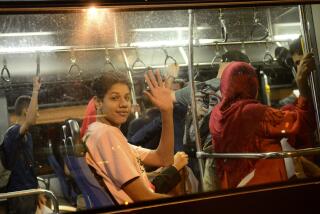Gunplay May Be Ending on Green Line : Somalia: A symbol of banditry dividing the capital is erased by a pact between warring clans.
- Share via
MOGADISHU, Somalia — On Friday afternoon, as he approached the Green Line that divides this city, Ahmed Hashi Seed stopped for gasoline--and a hired gun.
“You have to have a gun there,” he said, handing the automatic weapon to a guard in the back of his pickup truck. “Otherwise, people will intimidate you. Or kill you.”
The Green Line that divides two of Somalia’s warring clans is a mostly deserted four-mile road of bombed-out buildings that only the foolish dare travel, and then only with heavily armed bodyguards.
But a historic agreement reached Friday may forever erase the line from Mogadishu’s map of terror.
Somalia’s two most powerful rival clan leaders--forced together by a massive international effort to restore order here--agreed to “break the artificial lines in the capital city.” That may remove the most frightening, enduring symbol of the banditry that has taken thousands of tons of relief food from the mouths of starving Somalis and left thousands dead.
The usual tense atmosphere was evident on the line Friday, but most of the gunmen manning roadblocks there showed unmistakable signs of optimism that their long vigil was about to end.
At the most dangerous single spot in all of Somalia--an intersection that not even the U.S. Marines have dared to breach--gunmen ranging in age from 11 to 45, mouths full of the stimulant qat, manned a checkpoint for the militia controlled by Gen. Mohammed Farah Aidid.
Just 200 yards down the road, a checkpoint run by Aidid’s rival, Ali Mahdi Mohamed, was similarly manned. And, for the first time in weeks, a few cars were actually moving between the two sides, a sign that times already were changing.
Aidid’s hardened militia, commanded by a gaunt 35-year-old named Dahir Jimale, cracked brown-toothed smiles as news of the agreement blasted from their radios. Aidid and Mahdi had not only signed an agreement to remove the Green Line, the radio said, but they had sealed it with Islamic prayers and a public embrace.
“It’s possible this will end this fighting,” said Jimale, who commands a 52-man force that runs the checkpoint 24 hours a day. “For God’s sake, I hope it’s possible. There’s nothing better than peace.”
Within days, these men will no longer have jobs. But they had no fear of the future.
“There are many jobs we can do,” Jimale said. “These men were students, hotel managers, mechanics and drivers before this war started. If they come and open things up, everything will be OK in Somalia again.”
The Green Line was created nine months ago by the rocky cease-fire that ended a devastating four-month urban war between Aidid and Mahdi, who split soon after jointly toppling the government of President Mohamed Siad Barre. During those battles, heavy artillery from both sides laid waste to a vast section of the city of 1.5 million.
Since then, the truce has been regularly broken by daily gunfire and regular looting of passing cars and trucks by forces on both sides.
The division has been complicated in recent months by yet another clan leader, Mohamed Kanyare, who controls an area near the Green Line known as godka , the hole. Kanyare, though a Mahdi ally, has been opposed to reconciliation attempts. And his forces, operating with no apparent central control, have continued to terrorize residents.
“They are just bandits,” said Abdulahi Mohamed Weyne, 31, as he and other men hid in storefronts near Kanyare’s territory.
But, Weyne added, the agreement between Aidid, who controls about two-thirds of the city, and Mahdi, who is the country’s nominal interim president, will help force Kanyare to accept peace. “There will be great change,” predicted Weyne, who lost a leg in the revolution that drove Barre from power. “Work will soon be normal. We will be able to walk on our streets. And our many problems will end.”
Times staff writer Mark Fineman contributed to this story.
More to Read
Sign up for Essential California
The most important California stories and recommendations in your inbox every morning.
You may occasionally receive promotional content from the Los Angeles Times.














